Work, Learn, and Earn
The majority of college students in the U.S. who are studying toward a coveted college degree are also working.
Nearly 60 percent of college students are working learners.i
Additionally, 48 percent of high school students report working for pay outside of their home.ii
Individuals who work for pay and are enrolled in a formal learning program to earn a diploma, credential, or degree are known as working learners. With working and learning becoming increasingly common, it’s important to understand who working learners are and what the effects of juggling the demands of working and learning are on the academic and career outcomes of underserved working learners.
Working Learners Are Made Up of Individuals with Diverse Backgrounds
- 2/3 are 16-19 years old
- 1/3 are 30+ years old
- 62% White
- 16% Hispanic
- 12% African American
- 60% are women
- 19% have children
- 43% are from low-income backgrounds
Who Does (or Doesn’t) Work Work For?
Six million working learners have incomes at or below 200% of Federal Poverty Leveliv
Working learners, particularly underserved working learners who balance demanding work schedules with college course loads, face academic and career disadvantages compared to their peers who work fewer hours while in college.
With rising tuition and total attendance costs, it’s nearly impossible for today’s working learners to work their way through college. Most students take out loans to cover the difference.
71 percent of students at four-year colleges and 20 percent of students at two-year colleges graduate with student debt.v
College Student Work Characteristics
Students who work fewer hours benefit from work arrangements that accommodate the semester course schedule.
Yet, very few working learners have jobs on campus or through a federal work-study program.i
And students from low-income backgrounds often try to work more hours to offset their student debt, but working more demanding schedules hurts students from low-income backgrounds.i
Bachelor's Degree Attaintment 6 Years After Enrollment
Only 41.1 percent of low-income working learners who worked more than 15 hours each week had earned a bachelor’s degree within six years.i
However, low-income working learners who work less than 15 hours each week are more likely to graduate in six years and have higher incomes early in their careers.i
Policy Implications for Successiii
To improve achievement and career outcomes, working learners must have access to affordable higher education opportunities and resources to support them as they navigate their way through college as working students.
- Making college more affordable
- Expanding financial aid
- Raising wages for hourly and service workers
Colleges and universities can better support working learners by:
- Adopting more holistic advising approaches that account for both coursework and paid work
- Bridging the divide between campus career centers and financial aid offices to help place students into jobs with long-term career benefits
To improve achievement and career outcomes, working learners must have access to affordable higher education opportunities and resources to support them as they navigate their way through college as working college students.
Sources
- Blanchard Kyte, Sarah (2017). Who Does Work Work For? Understanding Equity in Working Learner College and Career Success. Iowa City, ACT Center for Equity in Learning.
- Blanchard, Sarah (2016). Getting Ahead, Getting Through, or Getting by? An Examination of the Experiences and Prospects of High School Working Learners. Washington, D.C. ACT Foundation.
- Carnevale, Anthony P., Melton, Michelle, Price, Eric W., and Nicole Smith (2015). Learning While Earning: The New Normal. Washington, D.C. Georgetown University.
- Carnevale, Anthony P. and Nicole Smith (2016). Learning While Earning: How Low Income Working Learners Differ From All Other American College Students. Washington, D.C. Association of American College Trustees.
- The institute for college and student access, March 2014. http://ticas.org/sites/default/files/pub_files/Debt_Facts_and_Sources.pdf
- Blanchard Kyte, Sarah (2017). Equity in Working and Learning Among U.S. Adults: Are There Differences in Opportunities, Supports, and Returns? Iowa City. ACT Center for Equity in Learning.

Work, Learn, and Earn
The majority of college students in the U.S. who are studying toward a coveted college degree are also working. Nearly 60 percent of college students – are working learnersi. Additionally, 48 percent of high school students report working for pay outside of their homeii.
Individuals who work for pay and are enrolled in a formal learning program to earn a diploma, credential or degree are known as working learners. With working and learning becoming increasingly common, it’s important to understand who working learners are and what the effects of juggling the demands of working and learning are on the academic and career outcomes of underserved working learners.
Who are Working Learners?
- 59 percent of college students work
- 29 percent of college students work 15 hours or less each week
- 30 percent of college students work more than 15 hours each week
- 41 percent of college students do not worki
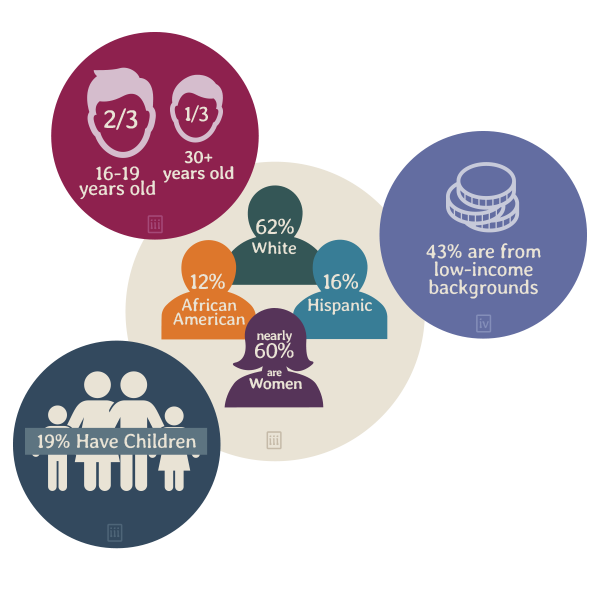
Working learners are made up of individuals with diverse backgrounds
- Two-thirds of working learners are 16-19 years old, while one-third of working learners are 30 or older.
- 62 percent of young working learners are White, 12 percent are African-American, and 16 percent are Hispanic.iii
- Nearly 60 percent of working learners are women.iii
- 43 percent of working learners are from low-income backgrounds.
- 19 percent of working learners have children.iii

Underserved students are overrepresented among those working more than 15 hours each week.iii
Who Does (or Doesn’t) Work Work For?
Six million working learners have incomes at or below 200% of Federal Poverty Leveliv
Working learners, particularly underserved working learners who balance demanding work schedules with college course loads, face academic and career disadvantages compared to their peers who work fewer hours while in college.
With rising tuition and total attendance costs, it’s nearly impossible for today’s working learners to work their way through college. Most students take out loans to cover the difference.
71 percent of students at four-year colleges and 20 percent of students at two-year colleges graduate with student debt.v
Who Does (or Doesn’t) Work Work For?
Six million working learners have incomes at or below 200% of Federal Poverty Leveliv
Working learners, particularly underserved working learners who balance demanding work schedules with college course loads, face academic and career disadvantages compared to their peers who work fewer hours while in college.
With rising tuition and total attendance costs, it’s nearly impossible for today’s working learners to work their way through college. Most students take out loans to cover the difference.
71 percent of students at four-year colleges and 20 percent of students at two-year colleges graduate with student debt.v
Students who work fewer hours benefit from work arrangements that accommodate the semester course schedule. Yet, very few working learners have jobs on campus or through a federal work-study program.i
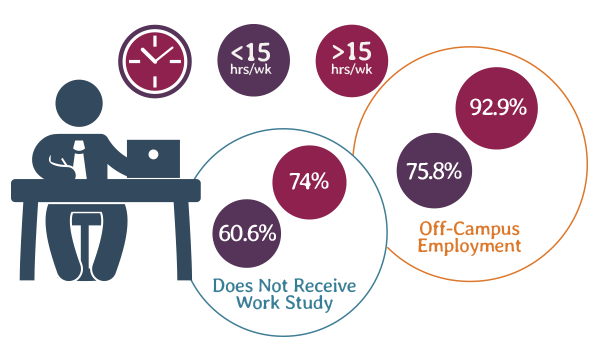
And students from low-income backgrounds often try to work more hours to offset their student debt, but working more demanding schedules hurts students from low-income backgroundsi
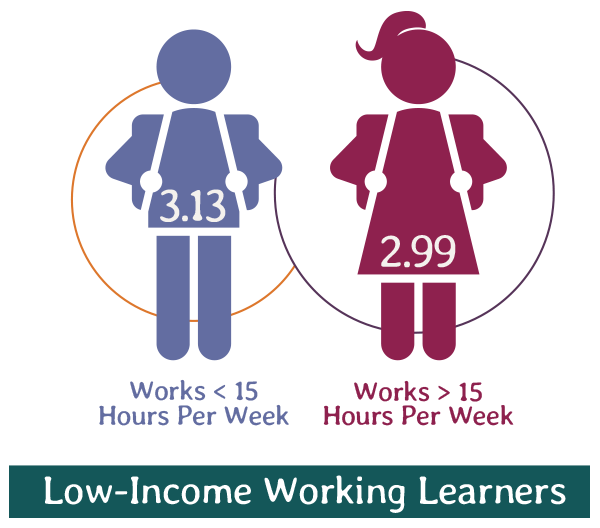
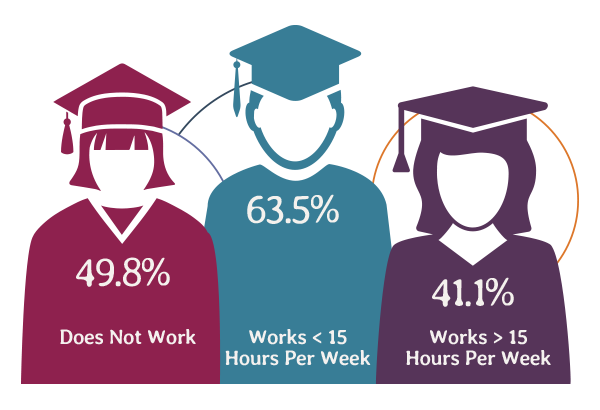
However, low-income working learners who work less than 15 hours each week are more likely to graduate in six years and have higher incomes early in their careers.i
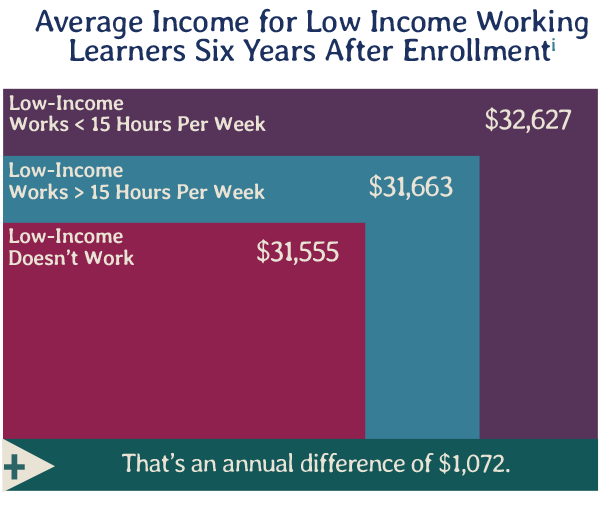
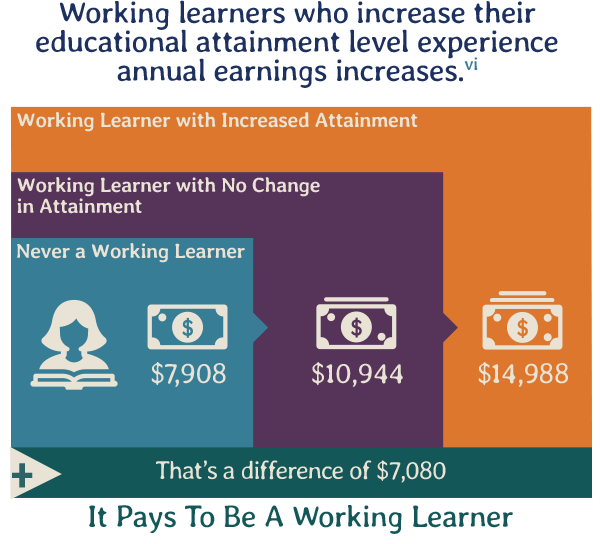
Working learners who increase their educational attainment level experience annual earnings increases.vi
Policy Implications for Successiii
To achieve educational equity, we must support working learners with policies and practices that minimize the disadvantages they face to earning a college degree, by:
- making college more affordable
- expanding financial aid
- raising wages for hourly and service workers
Colleges and universities can better support working learners by:
- adopting more holistic advising approaches that account for both coursework and paid work bridging the divide between campus career centers and financial aid offices to help place students into
- jobs with long-term career benefits
To improve achievement and career outcomes, working learners must have access to affordable higher education opportunities and resources to support them as they navigate their way through college as working college students.
Sources
iBlanchard Kyte, Sarah. Who Does Work Work For? Understanding Equity in Working Learner College and Career Success. Iowa City, ACT Center for Equity in Learning.
iiBlanchard, Sarah (2016). Getting Ahead, Getting Through, or Getting by? An Examination of the Experiences and Prospects of High School Working Learners. Washington, D.C. ACT Foundation.
iiiCarnevale, Anthony P., Melton, Michelle, Price, Eric W., and Nicole Smith (2015). Learning While Earning: The New Normal. Washington, D.C. Georgetown University.
ivCarnevale, Anthony P. and Nicole Smith (2016). Learning While Earning: How Low Income Working Learners Differ From All Other American College Students. Washington, D.C. Association of American College Trustees.
vThe institute for college and student access, March 2014. http://ticas.org/sites/default/files/pub_files/Debt_Facts_and_Sources.pdf
viBlanchard Kyte, Sarah (2017). Equity in Working and Learning Among U.S. Adults: Are There Differences in Opportunities, Supports, and Returns? Iowa City. ACT Center for Equity in Learning.
